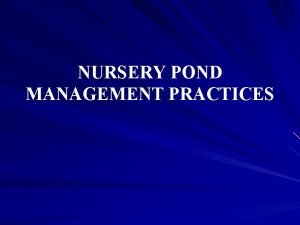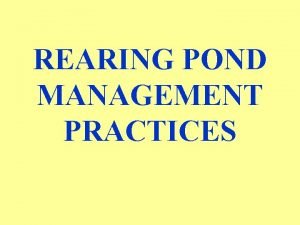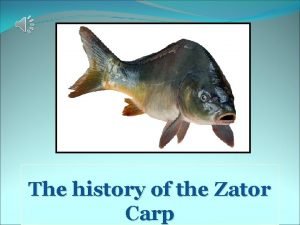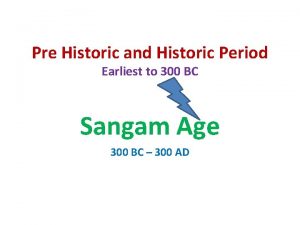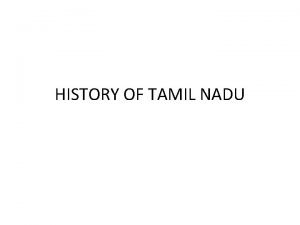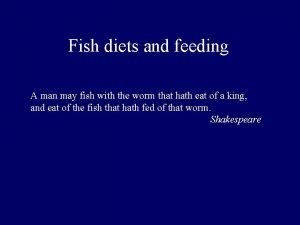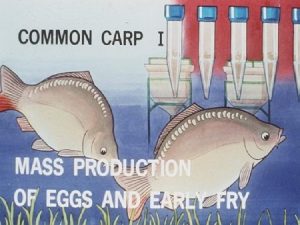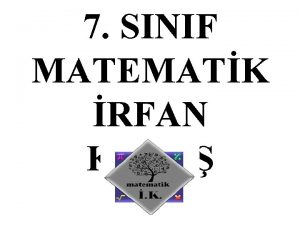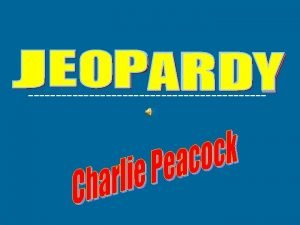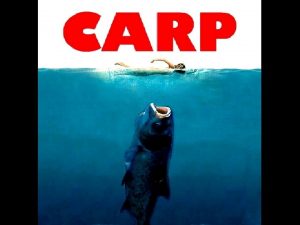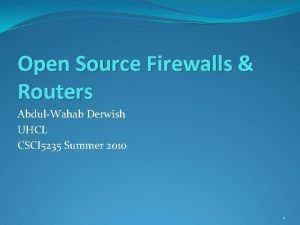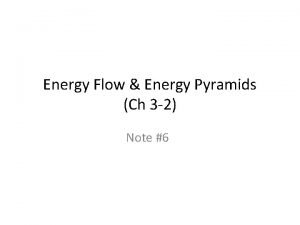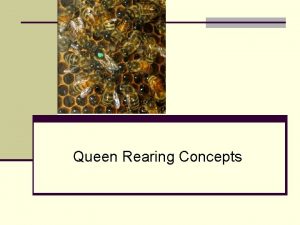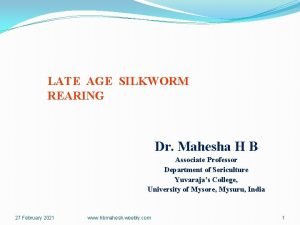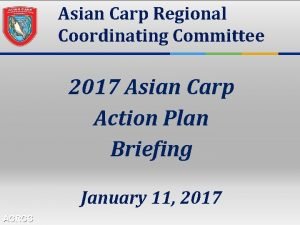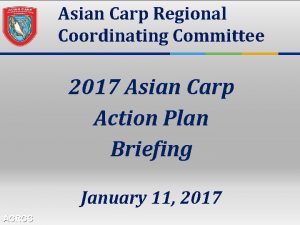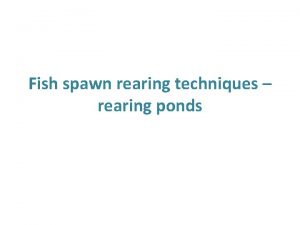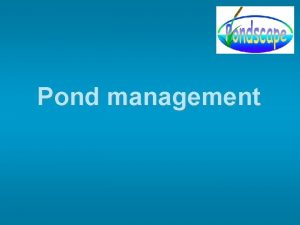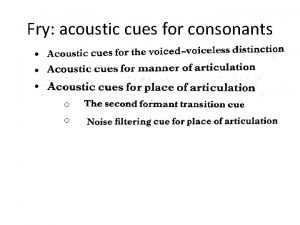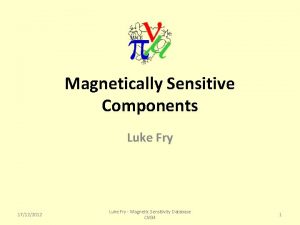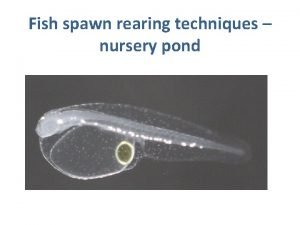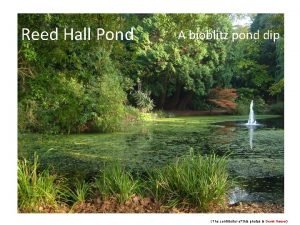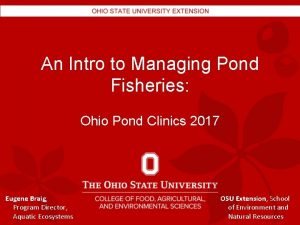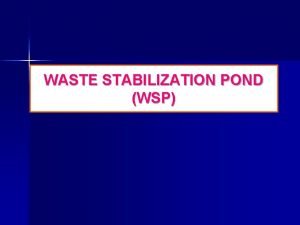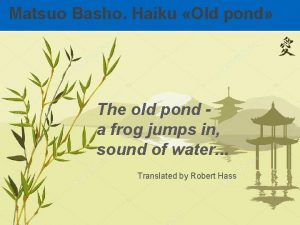REARING POND MANAGEMENT PRACTICES INTRODUCTION Fry of carp
















- Slides: 16

REARING POND MANAGEMENT PRACTICES

INTRODUCTION • Fry of carp measuring 20 -25 mm are raised further for 2 -3 months (june to sep. ) to fingerlings in relatively large ponds of 0. 05 -0. 2 ha with 1. 2 -1. 5 m water depth. • The food preference and feeding habit changes during its life cycles and they occupy different food niches. thus, series of management measure as that of nursery pond is also followed to ensure higher growth and survival. • the fishes are generally more dependable on artificial feed quality and quantity then natural food available

• Principle of rearing management: Rearing management based on the principle of well utilization of different food niches and the complete utilization of the quality artificial feed , and also give emphasis on the maintaining of good health with prevention from health hazard.

STEPS OF REARING POND MANAGEMENT 1. Pre stocking management: Eradication of predatory animals: -similar to the nursery pond management. For seasonal pond 1 st of all dry the pond up to witch the mud cracked. It help in control un wanted organism, pathogenic bacteria, and poisonous gases. Eradication and control of aquatic weed an algal bloom Soil correction by application of lime The management of theses two are similar to the nursery pond management. Assessment of food in nurseries : -the physiochemical parameters should be checked at regular interval both pre and post stocking of fry. No such more natural food may be available at the time of fry stocking.

Pond manuring and fertilization: - Manuring and fertilization is generally done in splits. The prestocking manuring is large quantity and other doses are less quantity at regular interval for the maintaining natural food. Initial manuring is done consideration the p. H and organic carbon content.

PRODUCTIVITY POOR MEDIUM HIGH (p. H<5. 5, o. m<0. 5%) ( p. H 5. 5 -6. 5, om-0. 5 -1. 5) ( p. H 6. 5 - 7. 5, o. m 1. 5 -2%) Nitrogen 225 -290 kg/ha Nitrogen 156 -225 kg/ha Nitrogen 112156 k/ha SSP 315 -405 kg/ha SSP Cow dung 10 tonne/ha or 220 -315 kg/ha Cow dung 8 -10 ton/ha or Biogas slurry 20 -30 ton/ha Biogas slurry 16 -20 ton/ha 16 ton/ha SSP 156 -219 k/ha C. D 5 -8 ton or B. S 10 - One third of the above is applied at 20 days interval.

PRE-STOCKING SECHEDULE AT A GLANCE • IN CASE THE POND IS TO BE POISONED Days Operation Day-1 Apply fish toxicant Day-2 Apply lime Day 3– 4 Rake the bottom Day 7– 8 Apply organic and inorganic manures Day 12– 14 Test the toxicity of water Check the abundance of natural fish food in the pond Day 13– 15 Stock the pond in case the pond is ready

• IN CASE THE POND IS TO BE DEWATERED Days Operation Day 1 Dewater the pond Day 2 Apply lime Day Allow it to dry till 3– 11 bottom soil cracks Day 11– 15 Fill with water or wait for the rain Apply organic and inorganic manure Day 18– 20 Check the abundance of fish food organisms Day 20– Stock the pond

B. Stocking management • Before stocking of fry we should examine the following. 1. All the physiochemical parameter and Toxic effect of the fish poison , fish food, of the water is suitable for the fry culture. 2. The fry should be take Prophylactic treatment before stocking to the pond. 3. In multi species stocking the ratio of the species with respect to the all niche should be properly utilized. 4. Stock only those fries which are healthy and active.

Some suggestions of Ratio of the species for stocking • Catla : Rohu: Mirigal 4: 3: 3 or 1: 1: 1 • Silver carp: grass carp: common carp 4: 3: 3 or 1: 1: 1 • Catla(30 -40%) : rohu(20 -30%): mirgala(15 -20%) : common carp(20 -25%) • Catla: rohu: mirigal : silver carp: grass carp : common carp 1: 1: 1: 1 In earthen ponds stocking density followed is 0. 20. 3 milon/ha. it can be increased if pond is having well managed facilities like water circulation/exchange or aeration.

C. Post stocking management 1. Supplementary feeding: -the same plant and animal origin feed ingredient which are used in nursery pond also used in rearing supplementary feed formation. It generally content higher percentage of protein with few fish attractants, and vitamin – minerals. • Commonly groundnut/mustard oil cake and rice bran/wheat-bran at 1: 1 ratio by weight. • Feed is provided at 8 -10%b. w/day during 1 st month then 6 -8% other two months. • Part of ration may be broadcast as powder formfor surface feeder.

2. Water management and health care: As we know that prevention is better then cure, we should conscious on water and health management Water management • we have to check the water quality by visual observation daily and also check the physiochemical parameter at every 10 days interval. • we have to minimized the feed wasting/residual. • Water exchange and circulation should be done at regular interval if there is no such aeration facility

POND AERATION

Health management 1. The stocking density should be proper. 2. Minimsed the stress through providing proper environment. 3. Regular sampling of seeds help in assessing there health and accordingly take any prevention or curative measures against the pathogen. 4. Remove the infected fish and through it away from the farm. 5. Always give a dip treatment of the stock either in potassium permanganate or salt solution before releasing them back to pond.

3. Harvestig and marketing • With in 2 to 3 month of rearing the fry grow to fingerling of size 80 -100 mm it is the time if harvesting. • Normal survival of 60 -70% is achieved in rearing pond with proper management. • Harvested stock are kept in crowded condition in hapa. stop before one day of transport. • Transport is generally done to long distance through polythene bag with originated.

THANK YOU
 Pre stocking management of fish pond
Pre stocking management of fish pond Rearing pond management
Rearing pond management Carp history
Carp history Ezhisai vallavan
Ezhisai vallavan Carp pandyas
Carp pandyas Carp teeth
Carp teeth Carp cycle
Carp cycle Carp egg
Carp egg Negatif tam sayılı kesri bileşik kesre çevirme
Negatif tam sayılı kesri bileşik kesre çevirme Slovakia christmas carp
Slovakia christmas carp What does the root word carp mean
What does the root word carp mean Four principles of design
Four principles of design Asian carp manitoba
Asian carp manitoba Carp vs vrrp
Carp vs vrrp How many trophic levels
How many trophic levels Queen rearing calendar
Queen rearing calendar Shelf rearing method
Shelf rearing method
